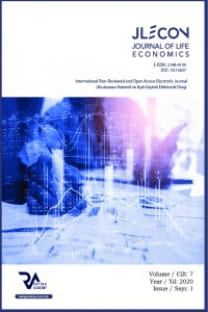THE DEMAND FOR ELECTRICITY CONSUMPTION IN TURKEY
Electricity Consumption, Fully Modified OLS (FMOLS)
THE DEMAND FOR ELECTRICITY CONSUMPTION IN TURKEY
Electricity Consumption, Fully Modified OLS (FMOLS),
___
- ALAWIN, M., AL-HAMDI, M., AND ALOMERI, M. (2016). Determinants of electricity demand in Jordan. Indian Journal of Science and Technology, 9(15).
- AL-FARIS, ABDUL RAZAK F (2002). The demand for electricity in the GCC countries. Energy Policy, 30(2), 117-124.
- BEDIR, M., HASSELAAR, E., AND ITARD, L. (2013). Determinants of electricity consumption in Dutch dwellings. Energy and Buildings, 58, 194-207.
- DEMIREL. (2016). Energy: Production, Conversion, Storage, Conservation, and Coupling, Springer-Verlag London Limited ENGLE, R. F., & GRANGER, C. W. (1987). Co-integration and error correction: representation, estimation, and testing. Econometrica: journal of the Econometric Society, 251-276.Engle-Granger
- EKPO, U. N., CHUKU, C. A., AND EFFIONG, E. L. (2011). The dynamics of electricity demand and consumption in Nigeria: application of the bounds testing approach. Current Research Journal of Economic Theory, 3(2), 43-52.
- FAKIH, A. AND MARROUCH, W. (2015) The electricity consumption, employment and growth nexus: evidence from Lebanon. OPEC Energy Review, 39: 298–321. doi:10.1111/opec.12053
- HUANG, W. H. (2015). The Determinants of Household Electricity Consumption İn Taiwan: Evidence from Quantile Regression. Energy, 87, 120-133.
- KARAKIŞ, ESRA, (2017), “Aylık Enerji İstatistikleri Raporu”, Enerji ve Tabii Kaynaklar Bakanlığı, Enerji İstatistikleri Daire Başkanlığı
- KRISHNAMURTHY, C. K., AND KRISTRÖM, B. (2013). Energy demand and income elasticity: a cross-country analysis. CERE Working paper 2013:5 Umea University Sweden
- KWAKWA, P. A. (2017). Electricity consumption in Egypt: a long-run analysis of its determinants. OPEC Energy Review, 41(1), 3-22.
- MOHAMED, Z., AND BODGER, P. (2005). Forecasting electricity consumption in New Zealand using economic and demographic variables. Energy, 30(10), 1833-1843.
- NASR, G. E., BADR, E. A., AND DIBEH, G. (2000). Econometric modelling of electricity consumption in post-war Lebanon. Energy Economics, 22(6), 627-640.
- ÖZDEMIR, N. (2012). Türkiye’de Elektriğin Tarihsel Gelişimi (1900 – 1938). Ankara: Elektrik Mühendisleri OdasıPhillips, P.C.B. and Hansen, B.E., (1990) Statistical inference in instrumental variables regression with I(1) processes. Review of Economic Studies 57, 99–125
- PHILLIPS, P. C., & PERRON, P. (1988). Testing for a unit root in time series regression. Biometrika, 75(2), 335-346.
- TAYLOR, L. D. (1975). The demand for electricity: a survey. The Bell Journal of Economics, 74-110.
- TURKSTAT. (2017) Main Statistics, http://www.turkstat.gov.tr/
- WORLD BANK. (2017) World Development Indicators 2017. Washington, DC. © World Bank. https://openknowledge.worldbank.org/handle/10986/26447 License: CC BY 3.0 IGO.”
- WORLD BANK. (2017) World Development Indicators 2017. Washington, DC. © World Bank. https://openknowledge.worldbank.org/handle/10986/26447 License: CC BY 3.0 IGO.”
- XIA, X. H., AND HU, Y. (2012). Determinants of electricity consumption intensity in China: analysis of cities at sub province and prefecture levels in 2009. The Scientific World Journal.
- YAVUZ, H., GÜRKAN, F. AND ŞIMŞEK, S. (2017) Enerji Sektörünün Osmanlı ve Türkiye Cumhuriyeti Tarihindeki Gelişimi ve Yasal Süreç, www.enver.org.tr/UserFiles/Article/5e907eb0-43e2-44cf-ba0b-811db7b7b2d2.pdf (access date: 19.12.20 17)
- Yayın Aralığı: Yılda 4 Sayı
- Başlangıç: 2014
- Yayıncı: Rating Academy
WEB ACCESSIBILITY OF MOOCS FOR ELDERLY STUDENTS: THE CASE OF TURKEY
ENFLASYONUN STOKASTİK BELİRLEYİCİLERİ: TÜRKİYE EKONOMİSİ İÇİN BİR NARDL YAKLAŞIMI
Mahmut Şaban AFSAL, İbrahim DOĞAN, Emre ÖRÜN, Bayram AYDIN
Nihan TOMRİS KÜÇÜN, Can YAMAN, Sezen GÜNGÖR, Sertaç EROĞLU
Ömer YALÇINKAYA, Muhammet DAŞTAN, Kerem KARABULUT
REKLAMLARA YÖNELİK DİKKATİN GÖZ İZLEME TEKNİĞİ İLE ÖLÇÜLMESİ VE BAĞLAM ETKİSİ
Can YAMAN, Nihan TOMRİS KÜÇÜN, Sezen GÜNGÖR, Sertaç EROĞLU
THE SUSTAINABILITY OF TOURISM COMPETITIVENESS IN TERNATE
Zümrüt Hatice ŞEKKELİ, İsmail BAKAN
DİNAMİK PROGRAMLAMA İLE AGV HATTI İÇİN VBA UYGULAMASI
Arzu EREN ŞENARAS, Şahin İNANÇ
